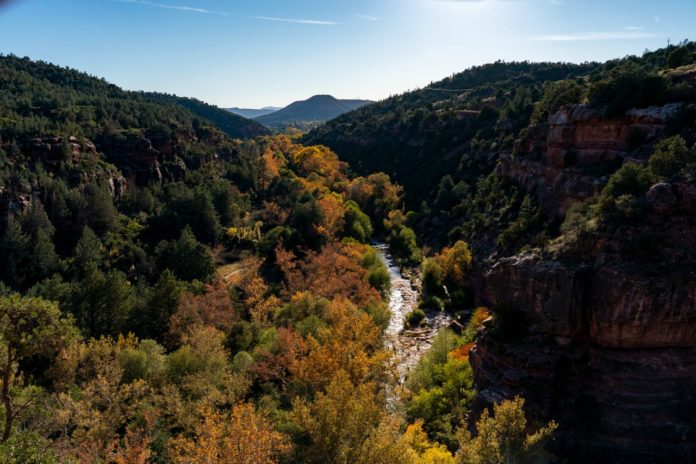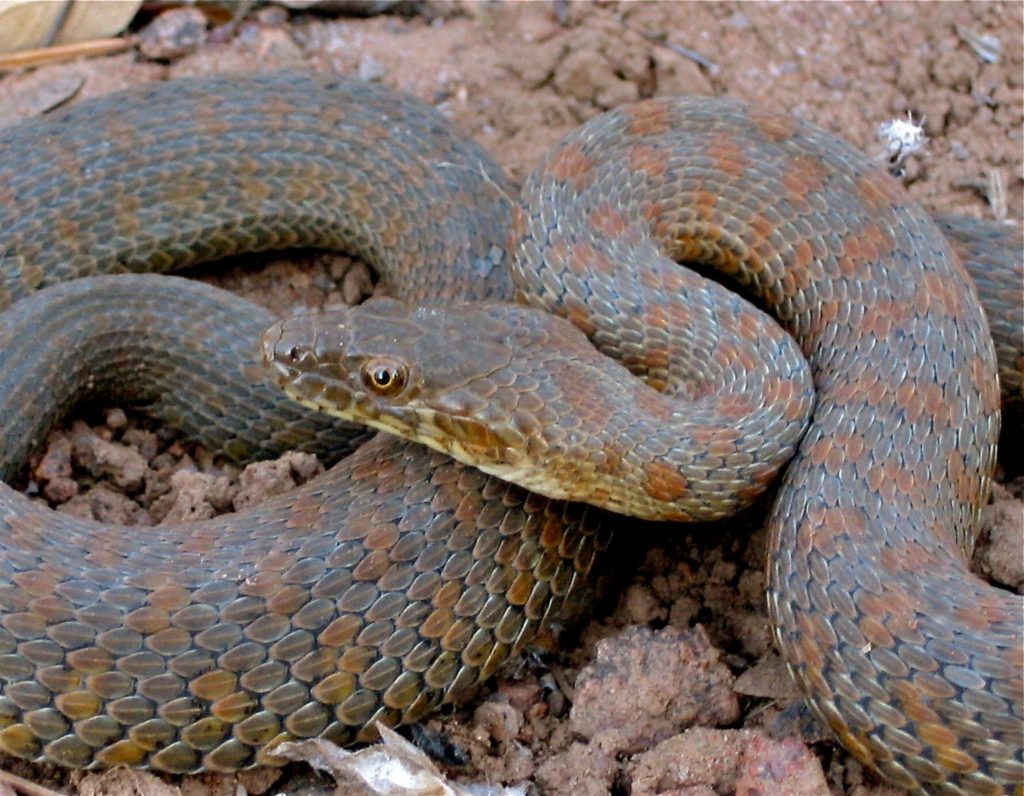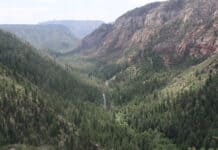
When a group of Arizona Conservation Corps workers were performing trail maintenance in upper Oak Creek Canyon last month, they came upon a rare sight next to an unofficial trail: Five olive gray snakes with faint reddish spots intertwined in courtship.
In a cell phone video of the menage-a-trois — or in this case menage-a-cinq — someone wonders out loud, “What are they doing?”
“I’d never seen anything like it before,” AZCC Crew Leader Hannah Greene, said. However, before commencing the Oak Creek Canyon project, AZCC crews had received training from Northern Arizona University biologist Erika Nowak, so the workers suspected it was a narrow-headed gartersnake — one of the oddest branches in the gartersnake family.
After they shared the photos and video with Nowak, the biologist confirmed the identification. The sighting was a rarity on top of rarity: The species is found in only a few streams in the Southwest and the courtship behavior observed is not well documented by science. In fact, Nowak said she is preparing a peer-reviewed article on the behavior observed by the team.
Coincidently, shortly before the crew’s sighting, the U.S. Fish and Wildlife Service officially designated stretches of upper Oak Creek and the upper Verde River as critical habitat for the narrow-headed gartersnake. The critical habit along Oak Creek runs from the switchbacks down to Lower Red Rock Loop Road.
Oak Creek Canyon is one of just five or fewer places with a “viable” population of the threatened snake, according to researchers in a FWS report.
The importance of enhanced protections for this threatened species was underscored by the sad sequel to the crew’s rare sighting: When workers returned to the same sport four hours later, the group of gartersnakes was gone, and one snake lay dead on the trail. Greene isn’t sure what happened, but she said the snake appeared to have been trampled. Nowak later collected the snake for study.
“It was hard to see this endangered snake [dead] we had seen just a few hours before.”
Unique Place, Unique Animal
The narrow-headed gardersnake is a product of its habitat. It specializes in catching fish in cold, fast-flowing streams cut into the Mogollon Rim in Arizona and New Mexico. The range of the narrow-headed gartersnake has shrunk in recent decades, limiting its range to a few isolated mountain streams separated by scores or hundreds of miles.

Unlike other gartersnakes, the narrow-headed gartersnake spends most of its time in or close to water, except when it moves away from the water to hibernate during winter. It took genetic tests to confirm the narrow-headed is actually a gartersnake and not a water snake.
Oak Creek Canyon is such an important stronghold for the remaining narrow-headed gartersnake population, that when the Slide Fire broke out in the canyon in 2014, biologists led by Nowak conducted a rescue mission to collect as many snakes as possible. The goal was to collect enough individuals to establish a breeding and reintroduction program, in case the fire or its aftermath wiped out Oak Creek Canyon’s narrow-headed garter snakes. The habitat damage from the Slide Fire ended up being less than biologists had feared.
The ongoing threats to the narrow-headed gartersnake include the loss of native fish, which are an important food source, loss of habitat from reductions in stream flow, and the introduction of invasive species that prey directly on the snake or displace the native fish that the snake depends on.
People can also pose a threat to the snakes.
“Being snakes, they are also threatened because people have ophidiophobia [fear of snakes],” Nowak said. “That is, people are afraid of snakes and kill them. We have seen recent examples of people killing these snakes in Oak Creek, so it’s important to get the word out that these snakes are not dangerous to people or pets and need our help to survive.”
The official designation of parts of Oak Creek and the Verde River as critical habitat means that federal agencies must consult with the Fish and Wildlife Service before approving projects or issuing permits within the habitat. The FWS will evaluate the proposals to ensure they don’t “adversely modify” the habit of the narrow-headed gartersnake.
Critical habitat designations do not affect private land “if there is no federal ‘nexus’ — that is, no federal funding or permits required to carry out the activity,” according to a FWS website.
Nowak said she was glad to see the critical habitat designation was finalized and included areas away from the creek where the snakes hibernate, which her research showed was important to their survival
“However, I am not sure that the final acreage designated as ‘critical’ is sufficient for species recovery,” Nowak wrote in an email, “because the designation was very narrowly limited to areas that were occupied by the snakes between 1998 and 2019.
“This designation of critical habitat doesn’t allow for the possibility of discovery of new populations in habitat we know is suitable (and these new discoveries are still occurring!), nor for the rediscovery of populations thought to be extinct. In some areas this narrow designation doesn’t allow for natural range expansion into formerly occupied habitat.”
Nowak said protecting the narrow-headed gartersnake is important because its health is a reflection of the canyon’s health.
“They are the reptilian ‘canaries in the coal mine’ for the health of higher elevation streams in Arizona and New Mexico. Their decline follows the decline and extinction of many species of native fish that the snakes rely on for prey, and this indicates that the health of these streams is imperiled.”
The Center for Biological Diversity environmental group praised the official designation in an Oct. 20 press release.
“Protecting these rivers will make a real difference for the narrow-headed garter snake,” Brian Segee, CBD’s endangered species legal director, wrote in the release. “The only way to save these river-dwelling snakes is to shield the places they live.”





















